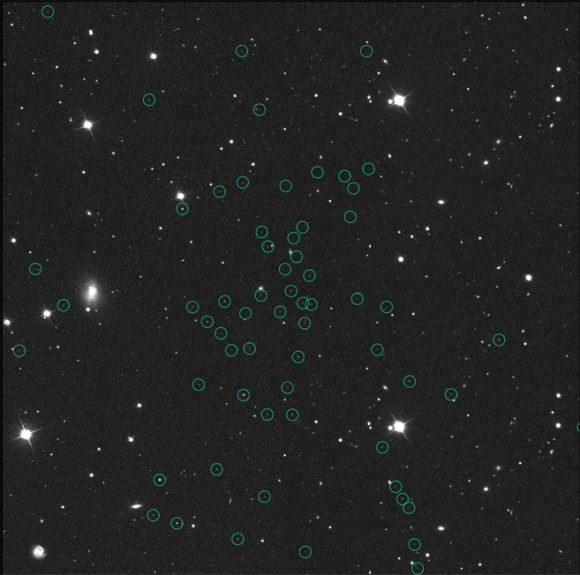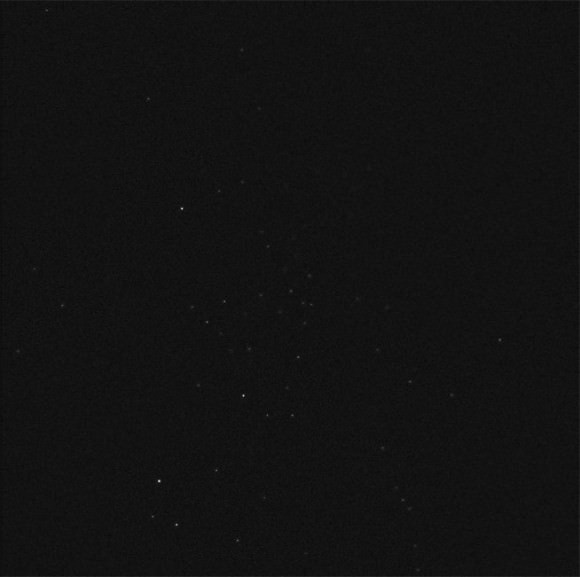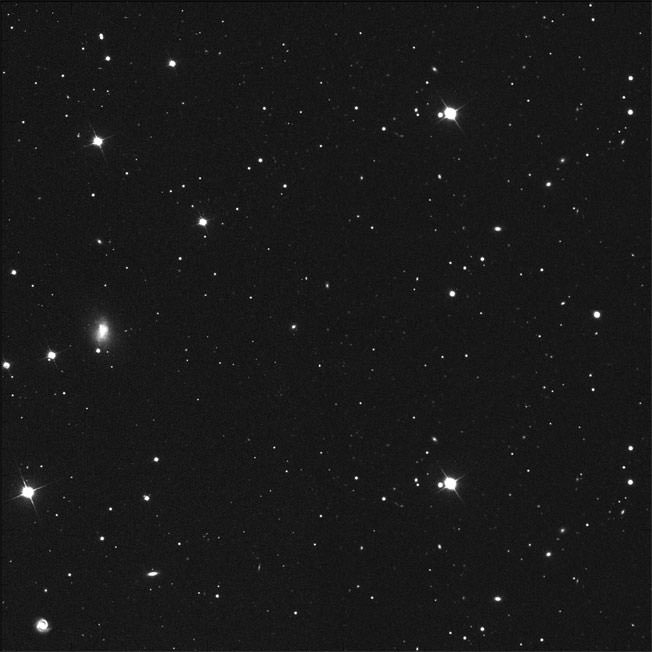[/caption]
Two years ago, Marla Geha, a Yale University astronomer, Joshua Simon from the Carnegie Institution of Washington, and their colleagues discovered something unusual while studying with the Keck II telescope and information for the Sloan Digital Sky Survey. Their observations turned up a contrasting group of stars which all appeared to be moving in unison – not just a moving cluster of similar stars which could have been torn away from the nearby Sagittarius dwarf galaxy. The team knew they were on to something, but a competing group of astronomers at Cambridge University was skeptical. Too bad… there was a dark treasure right there before their eyes.
Not to be dissuaded, Simon, Geha and their group returned to Keck and turned the photographic eye of the telescope’s Deep Extragalactic Imaging Multi-Object Spectrograph (DEIMOS) towards their target area. Even though it was only about 1,000 small, dim stars, they wanted to know how they migrated both in respect to the Milky Way and to each other. Named Segue 1, the target the team was looking at could possibly have 3,400 times more mass than can be accounted for by its visible stars… a galaxy dominated by dark matter and salted with a handful of ancient suns. If the 1,000 or so stars were all there was to Segue 1, with just a touch of dark matter, the stars would all move at about the same speed, said Simon. But the Keck data show they do not. Instead of moving at a steady 209 km/sec relative to the Milky Way, some of the Segue 1 stars are moving at rates as slow as 194 kilometers per second while others are going as fast as 224 kilometers per second.

“That tells you Segue 1 must have much more mass to accelerate the stars to those velocities,” Geha explained. The paper confirming Segue 1’s dark nature appeared in the May 2011 issue of The Astrophysical Journal. “The mass required to cause the different star velocities seen in Segue 1 has been calculated at 600,000 solar masses. But there are only about 1,000 stars in Segue 1, and they are all close to the mass of our Sun,” Simon said. “Virtually all of the remainder of the mass must be dark matter.”
But the information from DEIMOS didn’t stop there… It also revealed an eclectic collection of nearly primordial metal-poor stars. The researchers managed to gather iron data on six stars in Segue 1 with the Keck II telescope, and a seventh Segue 1 star was measured by an Australian team using the Very Large Telescope. Of those seven, three proved to have less than one 2,500th as much iron as the Sun. “That suggests these are some of the oldest and least evolved stars that are known,” said Simon. This is fascinating data considering investigations for stars of this type out of the Milky Way’s billions have produced less than 30. “In Segue 1 we already have 10 percent of the total in the Milky Way,” Geha said. “For studying these most primitive stars, dwarf galaxies are going to be very important.”

By confirming Segue 1’s massive concentration of dark matter, other types of research into this dark galaxy’s lifestyle now become more dedicated. The space-based Fermi Gamma Ray Telescope has also been looking its way in hopes of catching a gamma-ray event created by the collision and annihilation of pairs of dark matter particles. So far the Fermi telescope has not detected anything of the sort, which isn’t entirely surprising and doesn’t mean the dark matter isn’t there, said Simon.
“The current predictions are that the Fermi telescope is just barely strong enough or perhaps not quite strong enough to see these gamma rays from Segue 1,” Simon explained. So there are hopes that Fermi will detect at least the hint of a collision. “A detection would be spectacular,” said Simon. “People have been trying to learn about dark matter for 35 years and not made much progress. Even a faint glow of the predicted gamma rays would be a powerful confirmation of theoretical predictions about the nature of dark matter.”
Let’s hope Segue 1 isn’t alone in the dark.
Original News Source: Keck Observatory Science News.


Great job of detective work!
Wow! Such an old and DM imbued galaxy! I wonder if they know how old it is from the metallicity?
Old and (EM) cold… I am not going to sleep well tonight.
Simon says, but I do not quite follow. It is true that WIMP dark matter, weakly interacting massive particles, would annihilate if they are Majorana particles. (See the link.)
But very few, if any, of current known particles are Majorana particles. None of the Standard Model particles, except possibly neutrinos, are so.
So it isn’t a very likely a priori scenario. It reminds more of the drunkard that looks for his keys below the lamp post at nigh, because that is the only spot he can search. Then again, you do what you can do.
Majorana neutrinos should exist IMO. The neutralino is a condensate state of the supersymmetric partner of the photons, Z^0 and the Higgs. The super-partners of these particles all have the same quantum numbers.. The photon is its own anti-particle, so to speak, as is the case with the Z^0 and the Higgs. This then should hold for the supersymmetric fermionic partners. This would make them Majorana. A fermion that is Dirac has a discrete quantum number demarking it particle and anti-particle state. A Majorana fermion does not have this quantum number, but instead carries a topological index for the exchange of any two Majorana fermions. They have a knot topological number indicating the exchange of any two. The fermions as their own anti-particle will then annihilate itself.
A decent candidate for DM is the neutralino, and this should decay in the TeV range of energy. Gamma rays in that range of energy should be present, and there have been diffuse sources of such found near the center of the Milky Way galaxy.
LC
As for Majorana particles all by themselves, I can’t add to what I noted; hasn’t been seen, a priori unlikely.
But if they are tied, or can be tied, to supersymmetry, that would in my mind make them less likely, not more. Since you pointed out the Coleman-Mandula theorem I have become aware of the unnaturality of supersymmetry.
Or at least is how I naively interpret it, Coleman-Mandula speaks for a ground state of separated internal and external symmetries. Supersymmetry is a way to get around that, not a way to increase inherent symmetry I take it but maybe lowering it for all I know.
There are other ways, and except for symmetry breaking none of these have been observed.
Symmetry breakings would be expected in an expanding, cooling, universe.
Also, the anthropic possibilities that goes with that could perhaps be seen as another problem for the constraining mechanisms of SUSY and other CM breaking mechanisms. If the universe is anthropically selected, why would we expect extra constraints?
I realize this is handwaving, I need to look into the CM theorem et cetera.
The breaking of supersymmetry is an obstruction between the vacuum for internal and external symmetries. At higher energy where supersymmetry is recovered that obstruction is removed. The one nice thing about supersymmetry is that since bosons and fermions have + and – vacuum energies a SUSY world is one where the vacuum energy is completely zero.
In a basic N = 1 supersymmetry (one supergenerator) depending upon the phenomenology one dresses SUSY with (highly problematic actually) the lowest mass superpartner of particles we know would be the neutralino. This particle should be Majorana and act as its own anti-particle. So there should be processes of the form
N + N — > ? + ?. N + N — > Z + Z — > ?’s, N + N — > W^+ + W^- — > ?’s
The PAMELA detector did find gamma rays in the energy range within the window of expectation for these processes.
LC
alslam
http://i.imm.io/7vqY.jpeg
How come the bottom right and top right quadrants of the picture show the same stars??? It is like it has been transposed. There must be a mistake in the image…
I agree. Only the top-right quadrant appears to be duplicated (to bottom-right) though.
The linked original article shows this too, so looks like someone made a copy-paste error when (presumably) making a mosaic from smaller images?
If a copy paste error was made, why are the Segue I member stars not repeated in the top right quadrant as well?
They are, they’re just not circled. In fact, it seems all the circles in the top-right are empty… so I suspect an image layer with the circles on it was laid on top of the star image.
This is quite intriguing… I hope someone can resolve the mystery.
They probably tried to form a mosaic from a number of quadrantimages to get the image itself, and forgot to change a variable in the script they got to do it. The script function was probably intended to have the form mosaic(q1,q2,q3,q4) (forming the mosaic from the four separate quadrants), but instead they mistyped mosaic(q1,q2,q3,q3) or something similar – I do it all the time, and you have to watch out for it when scripting up complex tasks. The segue star indicator positions would be contained in a second overlay file that would not be affected, so you get the botched image with the correct overlay.
Anyway – that is my bet on what’s happened as an astronomer who routinely makes the same mistakes. The problem here is lax error checking – especially for a publicly released image!
I have a love-hate relationship to scripts and script languages. And they take so much time, even without these errors!
But it would take even more time without them.
Indeed – I fully agree… Love their work, but then there’s a whole bunch more work to do of their own making!
Maybe these are not stars, but alien ships.-
With engines.-
nice its getting to be realistic
Isn’t the Pak fleet supposed to come out of Sagitarius?
This is a rather strange object. The proportion of luminous to dark matter is extremely low. If I were to conjecture I would think this is the result of a galaxy collision, similar to the bullet galaxy cluster, where the dark matter component of the small galaxies continued on their trajectories, with some remnant of stars, while the luminous matter that is “sticky” was left behind somewhere. This collision may have occurred in the distant past, and Segue might be one component of this collision
Some comments about the picture are interesting. This appears to be a composite picture, where the left half is merged with two quarter parts on the right. This also raises a question of why the stars in this Segue dwarf galaxy outlined by circles are not also duplicated in the second picture.
LC
If the collision idea is correct and the majority of the dark matter got separated, I would be interested in seeing the luminous leftovers and how this remnant would differ in structure from a typical galaxy. Though it might not be possible to trace back the origin accurately enough or some other difficulty. I would think that it would help confirm some things almost as well as direct evidence…evidence of its absence.
The two blobs of dark matter pass through each other with little influence on each other, except for a transient tidal bulge. The luminous stuff in each galaxy interacts with itself more strongly, with things like nebular friction as they collide with each other. So it tends to stick to itself and the luminous matter from both galaxies tends to clump together, with some of the dark matter it gravitationally holds onto. So the two DM blobs, minus what ever part remains with the luminous stuff goes on their respective orbits. What is left of the luminous stuff is an elliptical galaxy and some small fraction of the DM.
What happens to the luminous stuff is difficult to say. If there is not enough gravitational potential to hold it together stars these stars may have enough kinetic energy so a good portion of them escape into intergalactic space. Presumably some small remnant might persist. The two DM blobs might carry a few stars with them as well. Without explicit calculations or numerical simulation it is difficult to say. Since the stars in this Segue galaxy are old it is likely this event happened a long time ago. Trying to back out the other remnants and piecing together their history might be rather difficult.
LC
That is a nice hypothesis, as it has happened before. The upshot would be that we have more examples to look for, quite many I would think.
This makes some sense. A very small dwarf galaxy might blow its luminous matter away by radiation pressure. On the other hand there are some pretty small dwarf galaxies out there which continue to have more stars than this.
LC
Update! Astrophysicist Ethan Siegel has a nice hypothesis that explains a diminishing trend in light/dark matter ratio vs galaxy size: it is radiation pressure that has a larger light matter stripping effect in smaller galaxies.
Update! Astrophysicist Ethan Siegel has a nice hypothesis that explains a diminishing trend in light/dark matter ratio vs galaxy size: it is radiation pressure that has a larger light matter stripping effect in smaller galaxies.
Very interesting subject, indeed!
Is there any data available about the actual distribution of these ~1000 stars? I mean, is its form spherical or elliptical? What are the smallest and the largest distances between the stars and their barycentre? Is there a massive object near to their barycenter?
…but I think it is much too early to have such information, isn’t it?